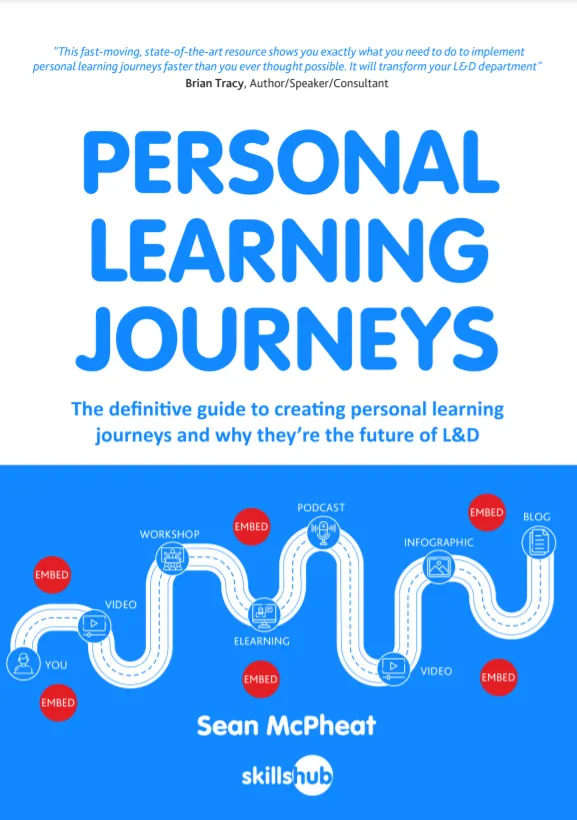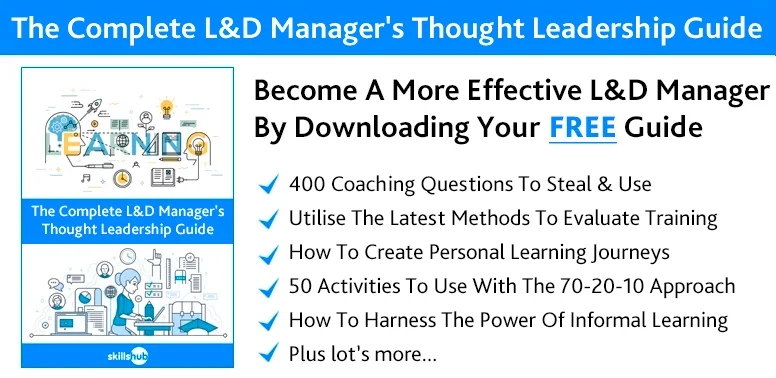
Mobile learning is a great addition to the L&D landscape. It’s popular too, with 72% of businesses saying it gives them a competitive advantage.
But it’s not all good. Mobile learning has its downsides and it’s best to know these before you dive in, as the pros and cons are relevant to learners too.
So in this article we thought we’d give you a balanced view of the advantages and disadvantages of mobile learning. But first, let’s start with what it is.
What is Mobile Learning?
Mobile learning, or m-learning, is changing the way we access and engage with educational content through mobile devices. By using mobile devices such as smartphones, tablets and laptops, mobile learning platforms and educational apps allow learners to access educational materials anywhere and anytime.
This flexibility means learning is no longer confined to a classroom or a set schedule. Learners and professionals can fit study sessions into their daily routine, whether it’s during a morning commute or a lunch break.
With the widespread use of mobile phones, m-learning is an essential tool for professional development and lifelong learning. Interactive quizzes, video content and multimedia elements are now at learners’ fingertips, catering for different learning styles and making the learning experience more engaging and effective.
Whether you like reading, watching or interacting with content, mobile learning platforms have educational materials tailored to you, so you can progress at your own pace and revisit topics as needed. This flexibility helps engagement and continuous learning for all learners.
What are the Key Features of Mobile Learning?
Mobile learning stands out for its flexibility, accessibility and adaptability. One of the key features of mobile learning is the ability to access educational content from anywhere, as long as there is a reliable internet connection. So learners are no longer limited by time or place. They can learn whenever it suits them best.
Adaptive learning technologies play a big role in personalising the learning experience, so content is tailored to each learner’s needs and progress. This boosts engagement and knowledge retention as learners can focus on areas where they need most support. Mobile learning also encourages continuous learning, so learners can reinforce previous learning and acquire new skills on an ongoing basis.
Interactive apps, multimedia elements and even social media notifications are integrated into many mobile learning experiences making it enjoyable and dynamic. By allowing learners to access educational content in different formats, mobile learning caters for different learning styles and keeps motivation high.
Mobile Learning Platforms
Mobile learning platforms are at the heart of the m-learning revolution, providing a seamless and interactive learning experience across multiple mobile devices. These platforms are designed to make educational content easily accessible, with features such as discussion forums, interactive quizzes and engaging games to reinforce learning.
Available on smartphones, tablets and other mobile devices, mobile learning platforms support both formal education and informal, self-directed learning.
Educational institutions and organisations are increasingly using these platforms to deliver content, so learners can study at their own pace and revisit materials as needed.
The benefits of mobile learning platforms are clear: they are cost effective, increase engagement and improve retention of educational content. By having interactive elements and a sense of community through discussion forums, these platforms make learning more collaborative and fun.

Advantages of Mobile Learning
Accessibility:
Being able to access learning content anywhere means students can learn on a flexible basis, in a location that suits them (bus, train, cafe) and at a time that works for them too. Mobile learning provides instant access to educational content on a mobile phone, removing location constraints and allowing learning anytime, anywhere.
There are often options for both online and offline content (which can be downloaded for access when students have no WiFi).
For students with visual or hearing disabilities, content can be shaped to work with text rather than sound, or with purely audio content, something that is hard to do in a classroom setting. Auto generated captions can be added to audio content as well as well composed Alt-text which fully describes photos and graphics.
Alternatively, separate streams of visual and audio content can be created to convey the same information – such as pairing a written article with an audio podcast.
Supports self paced learning:
People learn at different rates and mobile learning allows people to learn in their own way at their own individual pace. Many eLearning courses are modular and allow the user to dip in and out of an online platform which remembers exactly where they were last time they visited. They can also recap content they may not have understood on first attempt. Bite sized content allows learners to study in short, focused bursts, while personalised content and tailored content adapts to individual needs and preferences.
Compare this to a classroom where learners are generally limited to the pace of the trainer, which often causes frustration. The student may be so busy typing or writing notes that they aren’t actually taking in the information.
Most organisations have an eLearning platform with eLearning content that is mobile friendly. You can then learn whenever you want.
Content can be updated easily:
Unlike printed textbooks and course materials, online content is relatively easy to change, add to or edit. When there are new developments and discoveries to convey within a subject area, these can be added to the curriculum. Case studies can be kept up to date and relevant, replaced with new ones where necessary.
Even the dodgy fashion choices of webinar presenters can be improved, by re recording them with better styling!
Furthermore, subjects can be expanded with entirely new modules, or higher level courses can be offered in addition to low cost or free versions, increasing revenue for eLearning providers, or allowing for advanced certification for students.
Can cater for multiple learning styles:
Unlike classroom learning, mobile learning can be shaped to suit different learning styles, increasing learner engagement. Multimedia content and multimedia formats, such as videos, animations and podcasts, enrich the learning experience and cater for different preferences. Let’s look at some of the types of content you can create:
Text: Simple and direct, text can take the form of articles, short quotes or online captions for audio or video content.
Images: They say a photo equals a thousand words and it’s true that imagery can convey strong messages instantly. This is particularly effective when presenting Diversity, Equity and Inclusion training. Photos and graphics can also be used humorously to turn a dry subject, such as customer service, into something more engaging. Visual aids, such as images and diagrams, are especially helpful for explaining complex concepts.
Video: As with photographic imagery, video content can be highly involving, even if it’s just a presenter talking to camera. This can help inject some human personality into the content to counter the lack of interpersonal connection that eLearning sometimes suffers from. Video based content is shared 20 times more frequently than other content on LinkedIn, so it’s clear how engaging this is. Videos can also use visual aids to break down complex concepts, making them easier to understand.
Podcasts: Audio podcasts are so popular in everyday life, it’s a no brainer to ask employees to listen to one with an educational purpose. They are also cheap and easy to produce and can be shared across multiple platforms, increasing the reach of your eLearning content. As we discussed above, they are also ideal for visually impaired students.
Quizzes: Quizzes serve two purposes. They make learning more fun by adding an interactive and competitive element. They also provide valuable feedback to the eLearning provider on how well their content is connecting with learners. If too many students fail quizzes on multiple attempts then the quiz needs to be made easier or (more likely) the course content improved.

Learn How To Create Personal Learning Journeys For FREE!
Games: There are many ways to make learning more fun by gamifying the process, including “choose your own option” interactive video content and spot quizzes in the middle of content which unlock additional content. There are interactive graphics where the user highlights potential answers to questions, such as sources of risk in a health and safety scenario. They are then shown the correct answer. Educational activities in these games engage learners through interactive and gamified approaches, making learning more effective and enjoyable.
Text, images, video, podcast, quizzes etc. can all be flexibly incorporated into the content to suit different learning styles through your bespoke eLearning solutions.
Podcasts: Audio podcasts are immensely popular in everyday life, so it’s a friction free process to ask employees to listen to one with an educational purpose. They are also relatively cheap and easy to produce and can be shared across a range of platforms, expanding the reach of your eLearning content. As we discussed above, they are also ideal for visually impaired students.
Quizzes: Quizzes serve a dual purpose. They make learning more fun by bringing an interactive and competitive aspect to play. In addition, they can provide useful feedback to the eLearning provider regarding how well their content is connecting with learners. If too many students fail quizzes on multiple tries, then the quiz needs to be made easier or (more likely) the course content improved.
Motivation:
By using gamification methods, such as learning leader boards and other social status symbols like learning badges, mobile learning systems can make learning more fun and engaging. Employees start to compete with each other to get the highest score. Gamification creates an enjoyable experience and leads to higher engagement among learners.
Qualification and Certification:
It’s much easier to automate the process of test taking and certification when using an online platform, since it removes the subjectivity of a human examiner. Pass marks can be set purely on the responses the learner provides. eLearning platforms usually allow the student to retake the test after refreshing their understanding of the content.
Certificates can be auto generated including personalisation such as signatures or the student’s name and job title. These can either be downloaded as digital certificates or printed out and kept in an employee’s training file.
Data Capture:
Advanced methods exist to measure engagement on digital learning platforms, including cursor position, time on page, click frequency, video content views and more. This data can be turned into useful analytics to help eLearning providers refine their content or prove the effectiveness of their materials. Analysing engagement and progress can also help improve educational outcomes by identifying what works for learners.
Plus you learn a little about student behaviour with subtle engagement monitoring, such as the time of day or week that students choose to learn. While the student is learning a tough subject, you are learning about them!
Cost:
And let’s not forget the bottom line! There’s no comparison between running in person training courses for a national franchise and providing an accessible, flexible online learning platform that’s available anywhere in the country.
Even if you only have one head office full of employees to train, the logistics of getting everyone together at the same time can be challenging, requiring an employer to run multiple in person sessions. Even then, someone will be on sick leave or annual leave.
A well designed eLearning course can be used for years and can be taken by unlimited numbers of employees, providing excellent ROI. Mobile learning also reduces costs by eliminating the need for printed materials such as textbooks and handouts.
Summary of Advantages:
Mobile technology is the enabler of flexible and accessible learning, allowing learners to benefit from immediate access, personalised and tailored content, and a variety of multimedia formats, all delivered conveniently on a mobile phone.

Disadvantages of Mobile Learning
Eye Strain:
Sometimes the convenient small screen on mobile phones can be a big drawback, as reading documents on a small screen can cause eye strain.
Studies have shown that overexposure to blue light such as that produced by smartphones can cause broken sleep patterns. Blue light restricts the production of melatonin which regulates your circadian rhythm (sleep wake cycle) leading to disrupted sleep.
We’ve all experienced this when scrolling on our smartphones before bed!
Distractibility:
The hyper connected smartphone user may receive (or expect to receive) multiple SMS, social media or news notifications during a mobile learning session. Gaming apps on mobile devices can also be a big distraction, tempting learners to play instead of focus on their studies.
This reduces the learner’s sense of solitude, which could lower the learner’s engagement compared to a classroom experience.
Too Much Screentime:
As well as eye strain, there are other health risks associated with too much screen time including repetitive strain injuries and social withdrawal. You need to strike a balance between screen use and face to face communication.
Lack of Social Interaction:
For the value of good mental health and because it provides a different type of positive reinforcement, having an in person tutor providing real time feedback can be very beneficial. But this will entirely depend on the individual abilities of the teacher and some students don’t perform as well in classroom settings as they would with individual learning.
Underperforming technology:
This can be said of most smartphone applications.
Mobile learning courses can drain phone batteries quickly and struggle in areas of poor connectivity, leading to an unintentionally fragmented learning experience that reduces engagement. Lack of standardisation:
Device compatibility issues can arise as there is no standardisation in smartphones.
Learners may have different operating systems, or incompatible versions of the same OS. Screen sizes differ between releases, as does battery life and so on.
As a result some learners may not be able to load courseware while others can, meaning learning content delivery can be compromised and some students may be disadvantaged.

Mobile Learning Challenges
While mobile learning offers many benefits, it also comes with its own set of challenges. One of the main disadvantages of mobile learning is the distractions, especially when learners are in areas with unreliable internet connections or are frequently interrupted by social media notifications. These distractions can disrupt the learning experience and make it harder to focus.
The digital divide is another big barrier, particularly in rural areas or among learners from lower income backgrounds. Limited access to mobile devices and reliable internet connections can prevent some students from fully participating in mobile learning opportunities. Technical issues, such as device compatibility problems and concerns about too much screen time, can also hinder the effectiveness of m-learning.
And many businesses, schools and educational institutions don’t have the physical resources or infrastructure to support mobile learning. This limits the reach and impact of mobile learning, especially in areas where technology is not so accessible. But with some planning and investment mobile learning can still work for everyone.
In Summary:
All these disadvantages can be countered, however, with well-written and optimised elearning course content, so we still believe the benefits of mobile learning outweigh the disadvantages.
As an eLearning company, Skillshub is committed to creating efficient and impactful learning experiences. Contact us to find out more.













